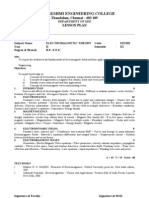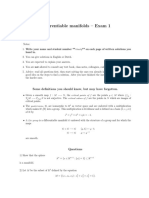Program Matlab
Uploaded by
Dewi RohmayaniProgram Matlab
Uploaded by
Dewi Rohmayaniy
PROGRAM MATLAB
% define model h = [0.2 0.2 0.3]; vp = [1.5 2 2.5 3.0]; vs = [0.75 1.0 1.25 1.5]; D = [0.05:0.05:2]; % hitung travel-time (P-reflected) [pr,tr] = raytr(h,vp,D); plot(D,tr,'k'); axis ij; % hitung gelombang langsung P tdp = D/vp(1); hold on; plot(D,tdp,'r'); %hold off; % hitung gelombang GR tgr = 2.*D/(0.9*vp(1)); plot(D,tgr,'b'); %hold off; % hitung headwave lapis 1 thcrit = asin(vp(1)/vp(2)); xcrit = 2*h(1)*tan(thcrit); ihw = find(D>=xcrit); DHW = D(ihw); thw = DHW/vp(2)+2*h(1)*sqrt(vp(2)^2-vp(1)^2)/ ... (vp(1)*vp(2)); plot(DHW,thw,'m'); %hold off; % hitung P-S wave [pps,tps] = raytrps(h,vp,vs,D); plot(D,tps,'r'); %hold off % hitung multipel : 1 2 2 2 2 1 imult = [1 2 2 2 2 1]; [pm,tm] = raytrmul(h,vp,D,imult); plot(D,tm,'g'); hold off
PROGRAM JEJAK SINAR & KURVA WAKTU TEMPUH
%%%by Agus Abdullah, PhD %%%just for ensiklopediseismik clear; clc for z=1:9 lap=[1:9]; nolayers=lap(z); norays=15; %untuk setting theta di bawah, hati-hati dengan jumlah rays terhadap critical angle!!! vel=[1500,1800,2200,1850,2400,2000,2700,2000,2900]; %kecepatan setiap lapisan dz=[300,500,600,250,300,400,120,400,200];%ketebalan setiap lapisan for i=1:norays theta(i)=i*2; %sudut tembak sinar end for k=1:norays for i=1:nolayers-1 theta(i+1,k)=(180/pi) * asin(sin(theta(i,k).*pi/180).*(vel(i+1)./vel(i))); %menghitung perubahan sudut sinar di setiap lapisan dengan menggunakan hukum snellius end end for k=1:norays p(k)=sin(theta(1,k).*pi/180)./vel(1); %menghitung ray parameter end for k=1:norays for i=1:nolayers
dx(i,k)=(p(k)*vel(i).*dz(i))/sqrt(1-p(k)*p(k).*vel(i).*vel(i)); %menghitung jarak lateral di setiap lapisan dt(i,k)=dz(i)/(vel(i).*sqrt(1-p(k)*p(k).*vel(i).*vel(i))); %menghitung waktu tempuh di setiap lapisan end end for k=1:norays twt(k)=2*sum(dt(:,k)); %menghitung twt untuk masing-masing sinar end %%%memanipulasi offset dx_down=dx; dx_up=flipud(dx_down); dx=[dx_down;dx_up]; dx(1,1)=dx(1,1); for k=1:norays for i=2:nolayers*2, dx(i,k)=dx(i-1,k)+dx(i,k); end end nol=[1:norays]*0; dx=[nol;dx]; %%memanipukasi kedalaman dz=dz(1:nolayers); dz(1)=dz(1); for i=2:nolayers, dz(i)=dz(i-1)+dz(i); end dz_down=dz'; dz_up=flipud(dz_down); dz_up=dz_up(2:nolayers); dz=[0;dz_down;dz_up;0]; offset=dx(nolayers*2+1,:); % plot hasil for k=1:norays subplot(1,2,1) plot(dx(:,k),dz); hold on end xlabel('offset(m)') ylabel('depth(m)') title('Jejak Sinar') state=set(gca,'ydir'); if (strcmp(state,'reverse')) set(gca,'ydir','reverse') else set(gca,'ydir','reverse') end a=size(dx); dx=reshape(dx,a(1,1)*a(1,2),1);
x = [0 max(dx)]; for i=1:nolayers y = [dz(i) dz(i)]; plot(x,y,'r'); hold on end axis([0 max(dx) 0 max(dz)]); subplot(1,2,2) plot(offset,twt,'linewidth',3); grid on; hold on xlabel('offset(m)') ylabel('twt(s)') title('Kurva Waktu Tempuh') state=set(gca,'ydir'); if (strcmp(state,'reverse')) set(gca,'ydir','reverse') else set(gca,'ydir','reverse') end clear end
function [h,hva]=wtva(s,t,kolor,snot,polarity,dir,resampfact) if(nargin==0) t=0:.002:2.0; r=randn(size(t)).^5; tw=-.1:.002:.1; arg=(pi*15*tw).^2; w=(1-2.*arg).*exp(-arg); s=conv(r,w);
s=s(51:length(t)+50); s=s/max(s); figure end if(nargin<7) resampfact=1; end if(nargin<6) dir=1; end if(nargin<5) polarity=1; end if(nargin<4) ilive=find(~isnan(s)); snot=mean(s(ilive)); end if(nargin<3) kolor='g'; end if(abs(polarity)~=1) error('invalid polarity value'); end test=sum(abs(s-snot)); if(test>1000*eps) dt=t(2)-t(1); ss=polarity*[snot;s(:);snot]; n=length(ss); tt=[t(1)-dt;t(:);t(length(t))+dt]; il=find(ss<=snot); ilow=[0;il;n+1]; ind=diff(ilow); ibdy=find(ind>1); ind=find(diff(ibdy)==1); ising=ilow(ibdy(ind)+1); if(~isempty(ising)) if(ising(1)==0) ising(1)=[]; end if(ising(length(ising))==n+1) ising(length(ising))=[]; end if(~isempty(ising)) for k=1:length(ising) ss=[ss(1:ising(k));ss(ising(k));ss(ising(k)+1:length(ss))]; tt=[tt(1:ising(k));tt(ising(k));tt(ising(k)+1:length(tt))]; ising=ising+1; end end il=find(ss<=snot); ilow=[0;il;n+1]; ind=diff(ilow);
ibdy=find(ind>1); end ibdy1=ilow(ibdy); ibdy2=ilow(ibdy+1); if(ibdy1(1)==0) ibdy1(1)=[]; end if(ibdy1(length(ibdy1))==n+1) ibdy1(length(ibdy1))=[]; end if(ibdy2(1)==0) ibdy2(1)=[]; end if(ibdy2(length(ibdy2))==n+1) ibdy2(length(ibdy2))=[]; end tnot=(snot-ss(ibdy1))./(ss(ibdy1+1)-ss(ibdy1)); tnot=tnot.*(tt(ibdy1+1)-tt(ibdy1))+tt(ibdy1); tt(ibdy1)=tnot; tnot=(snot-ss(ibdy2))./(ss(ibdy2-1)-ss(ibdy2)); tnot=tnot.*(tt(ibdy2-1)-tt(ibdy2))+tt(ibdy2); tt(ibdy2)=tnot; ss(il)=snot*ones(size(il)); ss=[snot;ss(2:length(ss)-1);snot]; tt=[t(1);tt(2:length(tt)-1);t(length(t))]; else ss=s; tt=t; end if(dir==1) hva=patch('xdata',polarity*ss,'ydata',tt,... 'edgecolor','none','facecolor',kolor); else hva=patch('xdata',tt,'ydata',polarity*ss,... 'edgecolor','none','facecolor',kolor); end if(dir==1) h=line(s,t,'color',kolor); else h=line(t,s,'color',kolor); end if(nargout==1) h=[h hva]; clear hva; end
function fact=plotseis(smat,t,x,vaflag,fact,flipy,kolor,hax) % % fact=plotseis(smat,t,x,vaflag,fact,flipy,kolor,hax) % % PLOTSEIS does a quick plot of a seismic matrix in a figure window (made by plotseis). % It plots the columns as wiggle traces centered at their x coordinates. % Type plotseis with no arguments for a demo. % % smat...the seismic matrix to be plotted. Traces are assumed stored in % the columns smat. % t...time coordinates of traces. % ******default 0:.00w:(nrows-1)*.002 where nrows=number of rows in smat****** % vaflag...if 0, then the traces are plotted as wt (wiggle traces) % if 1, then the traces are plotted wtva (shaded peaks) % if 2 the reverve polarity wtva (shaded troughs) % *************default=1************* % fact...scaling factors. Make fact(1) bigger for bigger wiggle % traces. fact(2) controls the overall plot scale. If not % provided, it is computed as max(abs(smat)). To scale two % plots the same, capture the return value from the first and % provide is as fact(2) for the second % *************default=1.5************* % flipy...if1, then the y axis is reversed so that it goes from top % of window to the bottom % *************default=1************* % kolor...color to plot the traces
% % % % % % % % % % % % % % % %
*************default=[1 0 0] (red)************* hax...handle of the axis to plot the seismic matrix in. If -1, then a new figure is created. *************default=-1************* NOTE: To scale two plots with respect to the maximum absolute value on the first plot, capture the return value from the first and provide it as the fifth argument for the second plot: fact=plotseis(smat1,t1,x1); plotseis(smat2,t2,x2,1,fact); G.F. Margrave, Aug 1995 The CREWES Project Department of Geology and Geophysics The University of Calgary gary@geo.ucalgary.ca
if(nargin<1) % do a demo % make a fake reflectivity t=0:.002:1.0; r=randn(size(t)).^5; % make a ricker wavelet tw=-.1:.002:.1; arg=(pi*15*tw).^2; w=(1-2.*arg).*exp(-arg); % convolve s=conv(r,w); s=s(51:length(t)+50)'; s=s/max(s); smat=s*ones(1,20); end if(nargin<8) hax=-1; end if(nargin<7) kolor=[0 0 0]; end if(nargin<6) flipy=1; end if(nargin<5) fact=1.5; end if(nargin<4) vaflag=1; end if(nargin<3) ncols=size(smat,2); x=1:ncols; end if(nargin<2)
nrows=size(smat,1); t=0:.002:(nrows-1)*.002; end if(length(x)>1) bnds=(max(x)-min(x))/(length(x)+1); else bnds=max(smat-min(smat))/2; end if (length(fact)<2) ilive=find(~isnan(smat)); trcmin=min(smat(ilive)); trcmax=max(smat(ilive)); s=max([abs(trcmax) abs(trcmin)]); fact=[fact s]; end if(hax==-1) figure; else hfig=get(hax,'parent'); figure(hfig); set(hfig,'currentaxes',hax); end if(flipy) set(gca,'ydir','reverse'); end for k=1:length(x) trc=smat(:,k)/fact(2); ilive=find(~isnan(trc)); m=mean(trc(ilive)); trc=(trc-m)*bnds*fact(1)+x(k); if(~vaflag) line(trc(ilive),t(ilive),'color',kolor); elseif(vaflag==1) if(length(ilive)<length(trc)) idead=find(isnan(trc)); trc(idead)=x(k)*ones(size(idead)); end wtva(trc,t,kolor,x(k),1,1); elseif(vaflag==2) wtva(trc(ilive),t(ilive),kolor,x(k),-1,1); end end
You might also like
- Strategic Human Resource Management at Lloyds TSBNo ratings yetStrategic Human Resource Management at Lloyds TSB12 pages
- USD As The International Reserve Currency: Past, Present and Future For Macro Economics: Principles and PoliciesNo ratings yetUSD As The International Reserve Currency: Past, Present and Future For Macro Economics: Principles and Policies10 pages
- All AT25 or 27GL - New Exhaust ConnectionsNo ratings yetAll AT25 or 27GL - New Exhaust Connections6 pages
- An Overview of Concept of Marriage in Muslim LawNo ratings yetAn Overview of Concept of Marriage in Muslim Law5 pages
- D - 'L - Ve - M - 'L - Ge - Mi - Zaman (#568291) - 720120No ratings yetD - 'L - Ve - M - 'L - Ge - Mi - Zaman (#568291) - 72012010 pages
- Faculty of Engineering - CEES - University of RuhunaNo ratings yetFaculty of Engineering - CEES - University of Ruhuna51 pages
- Manual Del Operador Komatsu WB97S-2 MT-InGLESNo ratings yetManual Del Operador Komatsu WB97S-2 MT-InGLES321 pages
- Spanish For Great (Sarcasm Implied) Spanish For It S A Laptop, It S A Laptop! Oh My God, It S A Laptop! CNo ratings yetSpanish For Great (Sarcasm Implied) Spanish For It S A Laptop, It S A Laptop! Oh My God, It S A Laptop! C4 pages
- Student Solutions Manual to Accompany Economic Dynamics in Discrete Time, secondeditionFrom EverandStudent Solutions Manual to Accompany Economic Dynamics in Discrete Time, secondedition4.5/5 (2)
- Anderson-Björck For Linear Sequences : by Richard F. KingNo ratings yetAnderson-Björck For Linear Sequences : by Richard F. King6 pages
- L TEX For Examinations A Short Style Guide: Formatting MacrosNo ratings yetL TEX For Examinations A Short Style Guide: Formatting Macros7 pages
- Elements Ofdiffer & Intg Calculus Loomis PDFNo ratings yetElements Ofdiffer & Intg Calculus Loomis PDF318 pages
- Introduction to Complex Manifolds 1st Edition John M. Lee - Download the ebook now and read anytime, anywhere100% (1)Introduction to Complex Manifolds 1st Edition John M. Lee - Download the ebook now and read anytime, anywhere47 pages
- Coupled Spring Systems Using Matlab and GeoGebraNo ratings yetCoupled Spring Systems Using Matlab and GeoGebra7 pages
- Buy ebook Standardized Functional Verification 1st Edition Alan Wiemann cheap price100% (6)Buy ebook Standardized Functional Verification 1st Edition Alan Wiemann cheap price81 pages
- Applications of Second Order Differential Equation100% (1)Applications of Second Order Differential Equation6 pages
- Implicit Modeling of Complex Orebody With Constraints of Geological RulesNo ratings yetImplicit Modeling of Complex Orebody With Constraints of Geological Rules8 pages
- Part A Simulation: Matthias Winkel Department of Statistics University of OxfordNo ratings yetPart A Simulation: Matthias Winkel Department of Statistics University of Oxford54 pages
- JCMPHS Sy2023 Las Math9 Q4W1 Trigonometric RatiosNo ratings yetJCMPHS Sy2023 Las Math9 Q4W1 Trigonometric Ratios8 pages
- Complex Differentiation: Umberto L. Hryniewicz April 4, 2023No ratings yetComplex Differentiation: Umberto L. Hryniewicz April 4, 20233 pages
- Informal Lecture Notes For Complex AnalysisNo ratings yetInformal Lecture Notes For Complex Analysis21 pages
- Clarke Transform - Open Electrical-1 PDFNo ratings yetClarke Transform - Open Electrical-1 PDF3 pages

























































































